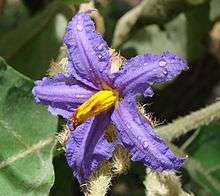Solanum lycocarpum
Solanum lycocarpum, or wolf apple, is common in the Brazilian savanna, the Cerrado ecoregion. The plant is called lobeira ("wolf's plant") or fruta-do-lobo ("wolf's fruit") in Portuguese. [1]
| Solanum lycocarpum | |
|---|---|
| Scientific classification | |
| Kingdom: | Plantae |
| Clade: | Tracheophytes |
| Clade: | Angiosperms |
| Clade: | Eudicots |
| Clade: | Asterids |
| Order: | Solanales |
| Family: | Solanaceae |
| Genus: | Solanum |
| Species: | S. lycocarpum |
| Binomial name | |
| Solanum lycocarpum | |
Names
The name wolf apple comes from the fact that they account for up to 50% of the Maned wolf's diet. It's Latin name "lycocarpum" is derived from two words the first being "lyco-" meaning wolf and "-carpum" meaning crop or picked.
Description

.jpg)
Wolf apples are a flowering shrub ranging in height from 1.2 to 3 m, with large, deeply lobed leaves covered in a soft grey-white fuzz. Their native range is the Brazilian savannah. It prefers moist, clay soil, full sun, and mild temperatures. Star-shaped blue or purple flowers appear from late fall to early spring, similar to the flowers of bitter nightshade. The large fruits (up to 13 cm in diameter) are golden yellow with variable red blushing when ripe. They resemble the tomato in external shape and internal morphology, but also the eggplant for the texture and color of the flesh, and in having a broad velvety cap.
Uses
Edibility
The ripe fruits are edible to humans, and are consumed by local populations in jams and preserves, but the unripe fruits are quite rich in tannin.[2] Solanum lycocarpum fruits can be used as a larvicide to ward off infections from organisms such as mosquitos. All other parts of the plant are poisonous. The fruits are used as a fallback source of food for cattle in the dry season.
Medicinally
Currently, there are no proven medicinal uses for the wolf apple, but the plant is used in the local folk medicine for obesity, cholesterol reduction, and as a treatment for diabetes in which can be an effective support.[2] It contains about 1.5% of glycoalkaloids in its dried fruits; consisting mainly of solamargine and solasonine in which its alkaloidic extract shows promising schistosomicidal activity that can prevent any parasitism. It is believed that the fruits protect the Maned wolf from infection of the Giant kidney worm, which is usually fatal for the animal.[2]
References
- Motta-Junior, J C; Talamoni, S A; Lombardi, J A; Simokomaki, K (1996). "Diet of the maned wolf, Chrysocyon brachyurus, in central Brazil". Journal of Zoology. 240 (2): 277–284. doi:10.1111/j.1469-7998.1996.tb05284.x.
- Fernando Tatagiba, Lobeira, fruta-de-lobo.
Further reading
- M. Motidome, M. E. Leekning, and O. R. Gottlieb A química de Solanáceas brasileiras. 1 - A presenca de solamargina e de solasonina no juá e na lobeira. Anais da Academia Brasileira de Ciências 42: 375–376 (1970).
- J.A. Lombardi and J.C. Motta Jr.) Seed dispersal of Solanum lycocarpum St. Hil. (Solanaceae) by the maned wolf, Chrysocyon brachyurus Illiger (Mammalia, Canidae). Ciência e Cultura 45: 126–127 (1993).
- A.T. Oliveira-Filho and L. C. A. Oliveira. Biologia floral de uma população de Solanum lycocarpum St. Hil. (Solanaceae) em Lavras. Revista Brasileira de Botânica 11: 23–32 (1988).
External links
| Wikimedia Commons has media related to Solanum lycocarpum. |
- Farina , Fabiane. “Glycemic and Urinary Volume Responses in Diabetic Mellitus Rats Treated with Solanum Lycocarpum.”, Feb. 2010.
- Bicalho Silva, Viviane de Cassia. “Larvicidal Activity of Oils, Fatty Acids, and Methyl Esters from Ripe and Unripe Fruit of Solanum Lycocarpum (Solanaceae) against the Vector Culex Quinquefasciatus (Diptera: Culicidae).” Oct. 2015.
- Miranda, Mariza Abreu, and Lizandra Guidi Malgahaes. “Evaluation of the Schistosomicidal Activity of the Steroidal Alkaloids from Solanum Lycocarpum Fruits.” Research Gate, 27 Jan. 2012.